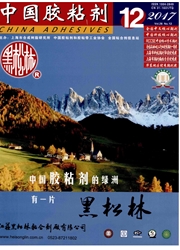

 中文摘要:
中文摘要:
采用液化技术和树脂化技术,制备了橡胶籽壳/苯酚液化物(简称液化物);然后以此为原料,制备了胶合板用液化物PF(酚醛树脂)胶粘剂,并采用单因素试验法和正交试验法优选出制备液化物PF的最佳工艺条件。研究结果表明:当反应温度为90℃、n(甲醛)∶n(液化物)=2.0∶1.0、反应时间为2.0 h和n(氢氧化钠):n(液化物)=0.7∶1.0时,由液化物PF胶粘剂压制而成的胶合板,其湿态胶接强度(为1.36 MPa)相对最大,并且达到GB/T 9846—2004标准中I类胶合板的指标要求;液化物PF与纯PF的结构基本相似,但前者的固化温度略高于后者、热稳定性低于后者。
 英文摘要:
英文摘要:
The rubber seed shell-phenol liquefaction (for short liquefaction) was prepared by liquefaction technology and resin technology. Then, with above liquefaction as raw material, so the liquefaction PF (phenol- formaldehyde resin) adhesive for plywood was prepared, and the optimal process conditions of preparing liquefaction PF were preferred by single-factor experiment and orthogonal experiment. The research results showed that the wetbonding strength ( 1.36 MPa) of plywood, which was made by liquefaction PF adhesive at suppression, was relatively maximum and could reach index requirement of type I plywood in GB/T 9846-2004 standard when reaction temperature and reaction time were 90 ℃ and 2.0 h respectively, molar ratios of n (formaldehyde) :n (liquefaction) and n (NaOH) :n (liquefaction) were 2.0:1.0 and 0.7:1.0 respectively. The structures between liquefaction PF and pure PF were mainly similar, but the curing temperature of the former was slightly more than that of the latter, and the thermal stability of the former was lower than that of the latter.
 同期刊论文项目
同期刊论文项目
 同项目期刊论文
同项目期刊论文
 期刊信息
期刊信息
